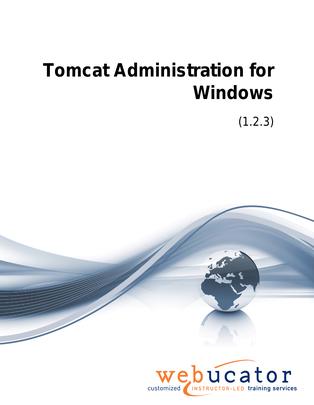
Tomcat Administration for Windows Courseware (TOM101)
This Tomcat Administration for Windows course provides a comprehensive understanding of Tomcat's key components and features. Students will learn about Tomcat's history, components, and JEE overview. The course covers essential topics such as installing Tomcat, understanding the directory structure, and configuring the server. Additionally, students will gain practical knowledge on deploying web applications, using the Tomcat Manager, working with JNDI Data Sources and JDBC, implementing security measures, and logging. The course also delves into monitoring, performance tuning, and clustering techniques to ensure optimal Tomcat performance.
Publisher: Webucator
Benefits
- Comprehensive Coverage: The course provides a thorough understanding of Tomcat Administration for Windows, covering essential topics and advanced techniques for optimal performance.
- Practical Examples: Real-world examples are incorporated throughout the course, enabling students to see how the concepts can be applied in practice.
- Hands-on Learning: The course includes numerous exercises that allow students to practice and solidify their newly acquired skills.
- Engaging Content: The courseware is designed to be interactive and engaging, keeping students interested and motivated to learn.
- Experienced Authors: The courseware is created by experienced Tomcat developers and administrators, ensuring high-quality content that is both accurate and up-to-date.
Outline
- Tomcat Introduction
- History of Tomcat
- Version Number and Features
- Tomcat Components
- Catalina
- Jasper
- Coyote
- JEE Overview
- MVC Design Pattern
- Servlets/JSP
- Directory Structure
- JNDI
- Installing Tomcat
- Download
- Installation
- Environment Variables
- Starting the Server
- Verifying Server Operation
- Stopping the Server
- Tomcat Directory Structure
- Batch files in /bin
.exefiles
/confserver.xmlcontext.xmlweb.xml
/logs/webapps/lib/work/temp
- Batch files in /bin
- Configuring Tomcat
- Role of
serverxml - Instance Layout
- Server
- Service
- Virtual Host
- Context
serverxmlelements<Server><Service><Connector><Engine><Host><Context><Realm><Valve>
- Role of
- Deploying Web Applications
- JEE Specification for Web Applications
- Servlets and JSP
- Model View Controller (MVC) Design Pattern
- Directory Structure
web.xml
- Document Base
- Context and the Document Base
- Default Context Descriptor
- Placing the Web Application Folders and Files under the Application Base
- Deploying a WAR file
AutoDeploy
- JEE Specification for Web Applications
- The Tomcat Manager
- /manager Web Application
- Managing Web Applications
- Deploying
- Listing Deployed Applications
- Reload Existing Applications
- Starting/Stopping
- Undeploying
- Listing Server Status
- Listing Security Roles in the User Database
- JNDI Data Sources and JDBC
- JNDI
- JDBC
- Drivers
- Data Sources in JDBC 20 and Later
- Connection Pooling
- Commons Database Connection Pooling
- Installation
- Guarding against Application Program Failure
- Configuration
- Data Source Definition
- Web Application
contextxml contextxmlin/confGlobalNamingResourcesinserverxml
- Web Application
- Troubleshooting
- Security
- Web Application Security
- Java SecurityManager
- Overview
- Standard Permissions
- Tomcat Permissions
- Starting Tomcat with a Security Manager Using the Default Policy File
- Secure Socket Layer (SSL)
- Generating a keystore File
- Modifications to
serverxmlfor SSL Support in Tomcat
tomcat-usersxml
- Logging
- Logging Overview
- Web Application Logging Techniques
javautilloggingjavaxservletServletContextlog4j
- Monitoring and Performance Tuning Tomcat
- Tomcat
- JVM
- JMX (Java Management Extensions)
- JMX MBeans in Tomcat
- Engine
JKMain- String Cache
- Server
- Users
- Configuring Tomcat to use MBeans
- Accessing MBeans
jconsolejVisualVM- PSI Probe
- Clustering
- Using Clustering for Replication and Load Balancing
- Running Multiple Instances of Tomcat
- Directory Setup
- Port Number Modifications
- All to All with
DeltaManager - Backup to One Cluster with
BackupManager
- Enabling Session Replication
- Session Persistence Using Shared File System
- Session Persistence Using Shared Database
- Session Persistence using Shared Database: Database Table
- In-memory Replication Using SimpleTcpCluster
- Load Balancing Using
mod_jkConnector to Apache2x Web Server
Required Prerequisites
None
Useful Prerequisites
- Experience with Java is helpful.
License
Length: 3
days | $120.00 per copy
What is Included?
- Student Manual
- Student Class Files